Record: 18-27-1
LEADERSHIP
Owners: Ray Babcock, James McKay & Phil Jacks
Coach: Sprague Cleghorn & James “Rusty” Hughes
Captain: James “Rusty” Hughes
FAST FACTS
• Brothers Earl and Dessie Roche were the first set of siblings to play pro hockey for the same Pittsburgh team. Midway through the season, rookies Jean and Conrad Bourcier became the second set of brothers.
• The Shamrocks played all of their home games at the Duquesne Gardens.
• 14 of the 26 Shamrocks had NHL experience.
• Only two players appeared in all 46 games for the Shamrocks: Bill Hudson and Scotty Martin.
• Two players from the team went on to play for the Pittsburgh Hornets the following season: Hudson and Bill Anderson.
These Shamrocks are unlucky.
LARRY WELCH, team general manager, summing up the team’s fortunes in the International Hockey League.
Shamrocks bring Pro Hockey back to Pittsburgh in 1935

-
February 4, 1936 – Members of the Pittsburgh Shamrocks (from left): Nick Wasnie, Billy Hudson, Scotty Martin, Conrad Bourcier, Henri Goulet and Jean Bourcier.
JAMES M. KUBUS
Pittsburghhockey.net Editor
Pittsburgh Had Two Teams to Watch at the Duquesne Garden
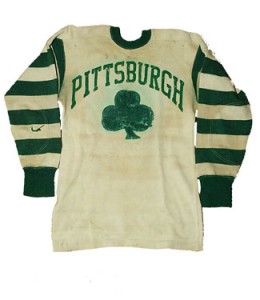 In the mid-1930s, the Pittsburgh region was beginning to emerge from the Great Depression and had not seen professional hockey for three years.
In the mid-1930s, the Pittsburgh region was beginning to emerge from the Great Depression and had not seen professional hockey for three years.
When the Pittsburgh Pirates failed after five seasons as the city’s first NHL franchise and crossed the state to become the Philadelphia Quakers in 1930 the Pittsburgh Yellow Jackets filled the void. The Yellow Jackets competed in the International Hockey League from 1930 to 1932 and were dormant for a year before competing in the X-Games in 1934-35.
The idea to return semi-pro hockey was discussed on April 13, 1935. The Pittsburgh Shamrocks sprouted when the idea was discussed by John Harris, owner of the Yellow Jackets, and Charles King, president of the International American Hockey League, met in Pittsburgh to discuss Pittsburgh’s possible entrance into the league in the fall.

-
Larry Welch
Larry Welch, a longtime hockey promoter at the Duquesne Garden, announced on September 8, 1935 that Pittsburgh had secured a team in the International league, pending league approval. Welch said the team, operating as the Pittsburgh Professional Hockey Club, Inc., owned by Ray Babcock, James McKay and Phil Jacks, had signed a two-year lease at the Garden and would play with six other teams in the league.
The plan established that Garden ice time would be split by the new IHL team and the Yellow Jackets, the newest members of the Eastern Amateur Hockey League.
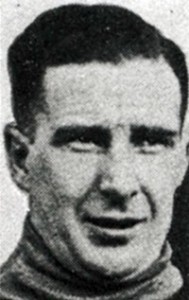
-
Sprague Cleghorn
Welch announced that Sprague Cleghorn, regarded as one of the dirtiest players in the NHL, would be the team’s head coach. Cleghorn led the NHL in penalty minutes for nine of the league’s first 10 years. Cleghorn won the Stanley Cup with the Ottawa Senators in 1920 and 1921 and with the Montreal Canadiens in 1924, helping him earn a spot in the Hockey Hall of Fame. Cleghorn’s brother, Odie, was the head coach of the Pittsburgh Pirates when the Pirates became the city’s first NHL team in 1925.
Cleghorn and Welch had two months to scour North America to assemble a roster.
Pittsburgh was officially admitted into the league when the International League Board of Governors met with John Chick, of Windsor, new league president of the IHL, at the William Penn Hotel in Pittsburgh on October 9, 1935. A report in The Pittsburgh Press had the first reference to the Pittsburgh Shamrocks. The board tried to establish a schedule for the 1935-36 season, but Chick ended the meetings prematurely pending the release of a revised National Hockey League schedule. Days before the board met, the Rochester Cardinals had announced that they would join the league to bring the the total of teams to eight.
Niagara Falls, Slowly, They Turned … Step by Step

-
The Pittsburgh Shamrocks during the Niagara Falls, Ontario training camp.
At the conclusion of the meetings, Welch announced that a training camp for the Shamrocks would take place in Niagara Falls, Ontario, on October 21. Niagara Falls was selected because the ice at the Duquesne Garden would not be ready until early November. Welch planned to invite 25 players to the camp and planned to cut the team to 12 players for the opening game against the Syracuse Stars on November 10.
Welch also announced that Pittsburgh would have first claim on spare players from the Montreal Canadiens and started by securing team trainer Steve Davis, who had spent three seasons with Montreal. Welch also negotiated a deal with the Philadelphia Arrows of the Can-Am League for forwards Stan McCabe, Billy Hudson, Eddie Owens (the only American born and trained player on the team) and defenseman Art Lilly, who eventually earned spots with the Shamrocks.
The Shamrocks also purchased goaltender Joe Starke from the NHL’s Chicago Blackhawks.
Four days before camp began, the Shamrocks signed three players from the Detroit Red Wings: Norm Walker and brothers Earl and Desse Roche. The Roche brothers became the first brother tandem ever to skate together on a professional Pittsburgh hockey team.
The blonde-haired brothers Earl, 25, and Desse, 27, each had three years of NHL experience. They started their pro careers with the Montreal Maroons in 1931 and played for the Ottawa Senators in 1932-33 before moving to the Red Wings.
The Shamrocks also added two former Pirates, Harold Darragh and Gord Fraser. Scotty Flash Martin was also added to the roster. Martin, a full-blooded Indian, was a left winger and a pure skater that can pick corners of the net with his shots, according to the Press.
The Rocks played four exhibition games with teams from the Can-Am league and closed the preseason by losing to the New Haven squad, 6-3.
The Shamrocks were prepared to start the season with Gordon Baxter in goal, but loaned him to Rochester and tabbed Starke as the goaltender.
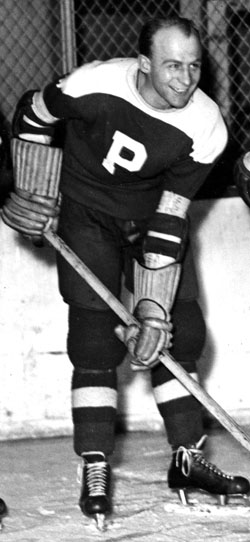
-
Center Bill Hudson (in practice jersey) scored the first Shamrocks goal and lead the team in scoring at the end of the season.
Good Luck Charms Deliver Strong, but Foggy Start
The International League inaugural season started with Pittsburgh visiting Syracuse on November 10, 1935.
Pittsburgh spotted the Stars a three-goal lead before Bill Ace Hudson scored the first goal for the Shamrocks at 4:28 of the second period. Martin and Henri Goulet also scored for Pittsburgh to tie the game before Norm Mann put the Stars up by one goal. Pittsburgh’s Owens tied the game 8:15 into the third. Syracuse’s Norval Fitzgerald drew a major penalty after he struck Desse Roche in the forehead with a high stick in the final minutes of the game. Goulet scored his second goal of the game on the power play and the Shamrocks defeated the Stars, 5-4.
The ˜Rocks returned to Pittsburgh one night later to acquaint themselves with the ice at Duquesne Garden on the eve of their home opener against the Cleveland Falcons. That game featured Melville Sparky Vail going against his former team. Vail had been engaged in a dispute with a teammate and Cleveland coach Hap Holmes and was subsequently sold to Pittsburgh after Holmes sided with Vail’s teammate.
Opening festivities featured a full orchestra in the Neville Street end zone of the Garden, but the scheduled 8:30 p.m. start time was delayed because of weather conditions unusually warm weather created a heavy fog that lingered inside the Garden all evening. Legendary Pittsburgh puckster Garnet Sixsmith dropped the ceremonial first puck in front of 3,000 fans. In 1902 Sixsmith played for the Pittsburgh Victorias, one of the first pro teams in North America and once scored 11 goals in a game at the Garden.
The Press explained that play was suspended three times while Garden attendants swept around the ice with blankets to fan out the vapor and reported, “the fog was so thick at times that it was almost impossible to see across the Craig Street rink.”
Hudson had a hat trick, including the game-winner, as the Shamrocks won, 6-5, and finished the night in first place in the Western Division of the league.
After the game, Welch announced that Rochester would be sending disgruntled winger Nick Wasnie to Pittsburgh in exchange for goalie Gord Baxter, who had been loaned to the Cardinals at the end of training camp.
The perfect start to the season ended quickly as the Falcons shut out the ‘Rocks two nights later in Cleveland to start a five-game losing streak.
Joe Starke would earn the first Shamrocks shutout by defeating the London Tecumsehs, 1-0, on December 7, before dropping the next four games.
Pittsburgh swept a three-game homestand around Christmas in what would be the longest winning streak in the team’s history.
The Shamrocks hosted the Tecumsehs on January 10, 1936 and set a record for the new league by scoring nine goals to win, 9-3. Four nights later, Pittsburgh tied Cleveland, 4-4, for its only tie of the season. The week ended with Starke’s second, and final, shutout after a 1-0 victory over Syracuse.
The Shamrocks had an agreement with the Chicago Blackhawks to send goaltender Lorne Chabot to Pittsburgh for reconditioning. Chabot won the Vezina Trophy the previous season and surely would have helped Pittsburgh for 10 games, but he refused to come to Pittsburgh and was suspended by Chicago.

- Joe Starke was injured, then released
Starke would play five more games for Pittsburgh; his last game was against the Buffalo Bisons on February 5. Starke surrendered four goals in 2:49 in the second period and was injured at some point during the Bison onslaught. Starke did not return to the net for the third period was replaced by Paul Gauthier. Five days later, after consulting with team physician Dr. L.M. Arons, Shamrocks President Ray Babcock unconditionally released Starke.
Gauthier, a 20-year-old goalie who had helped the Winnipeg Monarchs win the Canadian Junior Hockey championship, was signed by the Montreal Canadiens and loaned to the Shamrocks for the remainder of the season.
In mid-February the Shamrocks were 13-20-1 and in last place in the Western Division. Only Rochester in the Eastern Division had fewer wins in league play. Gauthier played well in relief and won four of his first six games to finish the February schedule.
Shamrocks Coach is Fired After Payday was Payless
March started ominously for the Shamrocks as Coach Cleghorn was dismissed by Babcock and was replaced by player/captain Rusty Hughes to finish the remaining 11 games. The disagreement that led to Cleghorn’s departure was highly publicized in the local newspapers.
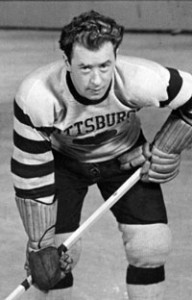
-
Desse Roche
The March 3 morning edition of the Pittsburgh Post-Gazette reported Cleghorn refused to leave with the team for a game in Windsor because the team had not been paid three days earlier.
The afternoon paper, the Press, had a terse response from Babcock: “I want to correct a statement given to local newspapers by Coach Sprague Cleghorn. The reason he did not accompany the Shamrock team on its trip to Windsor and Cleveland this week was due to the fact that Mr. Cleghorn had to be disciplined for misconduct covering the past month. For this misconduct it was deemed advisable to dispense with Mr. Cleghorn’s services as coach of the Shamrocks.”
On March 12, the Shamrocks lost to the Detroit Olympics, 4-0, and suffered their 15th consecutive road loss.
St. Patrick’s Day Was the Unluckiest Day for Region and the ‘Rocks
On March 16, the Shamrocks played host to Windsor and looked particularly bad early in a game that was a must-win for any hope of a post-season berth. The Bulldogs had a commanding 6-1 lead heading to the third period.
“Everybody thinks maybe this is the time to go home. But one never knows what the Rocks are liable to do. So the fans stick around. Waiting for what? They don’t know, but hope it’s something unusual,” the Press reported. Pittsburgh rallied to score five goals in the last stanza before a 7-6 loss in what would become the Shamrocks’ last game at Duquesne Garden. The loss to the Bulldogs mathematically eliminated the Shamrocks from the playoffs.
The next day, St. Patrick’s Day a day on which the Shamrocks might expect good luck saw their city crippled by the Great St. Patrick’s Day Flood of 1936. Following a winter that dumped more than 63 inches of snow on Pittsburgh, several inches of rain drenched the region in mid-March, including 1.75 inches on March 17. River waters rose to 21 feet above flood stage at the Point. The eventual-champion Olympics were scheduled to play at the Garden on March 20, but the widespread flooding cancelled the game and it was never rescheduled. A Pittsburgh-Rochester season finale was cancelled by Chick as both teams were already eliminated from the playoffs.
Pittsburgh finished their season with a 5-2 win in Syracuse on March 22. The game was meaningless for Pittsburgh, but had possible seeding implications. Before the game, it was reported that if the Stars won, Pittsburgh would be ordered to play the previously cancelled Detroit game to decide the race for first place between Detroit and Syracuse. Both teams would have been tied with 57 points, but Syracuse held the tie-breaker in goals.
Darragh’s goal with 15 seconds left in the game proved to be the final goal in team history.
At the end of the 1935-36 season, the Shamrocks had scored 137 goals and allowed 170. The Shamrocks finished in fourth place in the West Division behind Detroit, Cleveland and Windsor. All told, the Shamrocks finished with a record of 18-27-1 and lost over $40,000 in four months, according to the Press.
“These Shamrocks are unlucky,” Welch said, in summing up the team’s fortunes.
Predictably, the Shamrocks folded.
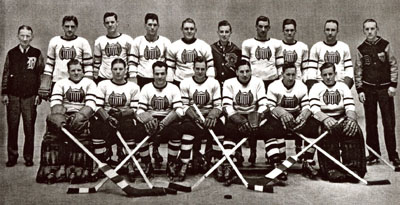
-
1935-36 IHL Champions – Detroit Olympics
Contrary to local legend, the Shamrocks did not evolve into the Pittsburgh Hornets. The Windsor Star reported that the Olympics, after winning the IHL championship in the spring of 1936, were purchased on October 4, 1936 by Yellow Jackets owner John Harris.
The Olympics moved to Pittsburgh to become the Hornets. The Hornets would play in the International American Hockey League, a merger of the International and Canadian-American Hockey Leagues.
Only two players from the Shamrocks, Bill Anderson and Bill Hudson, were on the Hornets roster to start the 1936-37 season. Hudson lead the Shamrocks in scoring (20+23=43) and was one of two players to play all 46 games for the Shamrocks. The other was Scotty Martin.
Nick Wasnie’s uniform courtesy of International Hockey Archives.
| Skater Stats | Regular Season | Playoffs | ||||||||||
| # | NAME | POS | GP | G | A | P | PIM | GP | G | A | P | PIM |
|---|---|---|---|---|---|---|---|---|---|---|---|---|
| 8 | Bill Hudson | C | 46 | 20 | 23 | 43 | 16 | — | — | — | — | — |
| 10 | Scotty Martin | LW | 46 | 20 | 19 | 39 | 33 | — | — | — | — | — |
| 9 | Nick Wasnie | RW | 35 | 14 | 22 | 36 | 58 | — | — | — | — | — |
| 4 | Dick Benson | LW | 41 | 14 | 20 | 34 | 12 | — | — | — | — | — |
| 11 | Stan McCabe | LW | 44 | 7 | 17 | 24 | 15 | — | — | — | — | — |
| Earl Roche | LW | 28 | 12 | 11 | 23 | 30 | — | — | — | — | — | |
| 18 | Harold Darragh | LW | 41 | 7 | 14 | 21 | 4 | — | — | — | — | — |
| 2 | Eddie Owen | LW | 43 | 5 | 13 | 18 | 62 | — | — | — | — | — |
| 5 & 6 | Melville Vail | D | 45 | 5 | 12 | 17 | 52 | — | — | — | — | — |
| Des Roche | RW | 25 | 7 | 7 | 14 | 26 | — | — | — | — | — | |
| 16 | Jean Bourcier | LW | 18 | 8 | 5 | 13 | 4 | — | — | — | — | — |
| 12 | Paul Goulet | LW | 37 | 7 | 5 | 12 | 22 | — | — | — | — | — |
| 14 | Phil Piche | LW | 26 | 1 | 6 | 7 | 0 | — | — | — | — | — |
| Gord Fraser | D | 15 | 4 | 2 | 6 | 14 | — | — | — | — | — | |
| 19 | James Hughes | D | 32 | 1 | 4 | 5 | 48 | — | — | — | — | — |
| 2 & 3 | Bill Holmes | C | 21 | 1 | 4 | 5 | 8 | — | — | — | — | — |
| 15 | Conrad Bourcier | C | 9 | 2 | 2 | 4 | 2 | — | — | — | — | — |
| Bill Anderson | D | 15 | 2 | 1 | 3 | 13 | — | — | — | — | — | |
| Norm Walker | RW | 8 | 0 | 1 | 1 | 2 | — | — | — | — | — | |
| Wilf Ranger | LW | 4 | 0 | 0 | 0 | 0 | — | — | — | — | — | |
| Len Leblanc | LW | 3 | 0 | 0 | 0 | 0 | — | — | — | — | — | |
| Art Lilly | D | 5 | 0 | 0 | 0 | 2 | — | — | — | — | — | |
| Roger Cormier | RW | 3 | 0 | 0 | 0 | 2 | — | — | — | — | — | |
| Ludger Desmarais | D | 4 | 0 | 0 | 0 | 2 | — | — | — | — | — | |
| Goalie Stats | |||||||||||||||
| # | NAME | GP | W | L | T | OTL | SOL | Min | GA | SO | GAA | G | A | P | PIM |
|---|---|---|---|---|---|---|---|---|---|---|---|---|---|---|---|
| 1 | Paul Gauthier | 16 | 7 | 9 | 0 | — | 990 | 56 | 0 | 3.00 | 0 | 0 | 0 | 0 | |
| 1 | Joe Stark | 30 | 11 | 18 | 1 | — | 1850 | 114 | 2 | 4.00 | 0 | 0 | 0 | 0 | |
